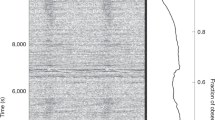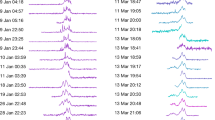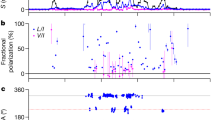Abstract
The radio properties of 4C21.53 have been an enigma for many years. First, the object displays interplanetary scintillations (IPS) at 81 MHz, indicating structure smaller than 1 are s, despite its low galactic latitude (−0.3°)1. IPS modulation is rare at low latitudes because of interstellar angular broadening. Second, the source has an extremely steep (∼v−2) spectrum at decametric wavelengths2. This combination of properties suggested that 4C21.53 was either an undetected pulsar or a member of some new class of objects. This puzzle may be resolved by the discovery and related observations of a fast pulsar, 1937+214, with a period of 1.558 ms in the constellation Vulpecula only a few degrees from the direction to the original pulsar, 1919+21. The existence of such a fast pulsar with no evidence either of a new formation event or of present energy losses raises new questions about the origin and evolution of pulsars.
This is a preview of subscription content, access via your institution
Access options
Subscribe to this journal
Receive 51 print issues and online access
$199.00 per year
only $3.90 per issue
Buy this article
- Purchase on Springer Link
- Instant access to full article PDF
Prices may be subject to local taxes which are calculated during checkout
Similar content being viewed by others
References
Readhead, A. C. S. & Hewish, A. Nature 236, 440 (1972).
Rickard, J. J. & Cronyn, W. Astrophys. J. 228, 755 (1979).
Hewish, A. & Okoye, S. E. Nature 207, 55 (1965).
Erickson, W. C. Bull. Am. astr. Soc. 12, 799 (1980).
Slee, O. B. Austr. J. Phys. Suppl. 36, 1 (1977).
Altenhoff, W. J., Dowries, D., Goad, L., Maxwell, A. & Rinehart, R. Astr. Astrophys. Suppl. 1, 419 (1979).
Erickson, W. C. Astrophys. J. (in the press).
Backer, D. C., Kulkarni, S. R., Heiles, C., Davis, M. M. & Goss, W. M. IAU Circ. No. 3743 (1982).
Ostriker, J. P. & Gunn, J. E. Astrophys. J. 157, 1395 (1969).
Swanenberg, B. N. et al. Astrophys. J. Lett. 243, L69 (1981).
Djorgovski, S. Nature 300, 618–619 (1982).
Author information
Authors and Affiliations
Rights and permissions
About this article
Cite this article
Backer, D., Kulkarni, S., Heiles, C. et al. A millisecond pulsar. Nature 300, 615–618 (1982). https://doi.org/10.1038/300615a0
Received:
Accepted:
Issue Date:
DOI: https://doi.org/10.1038/300615a0
This article is cited by
-
Maximal mass of the neutron star with a deconfined quark core
Journal of Astrophysics and Astronomy (2023)
-
Time domain astronomy with the THESEUS satellite
Experimental Astronomy (2021)
Comments
By submitting a comment you agree to abide by our Terms and Community Guidelines. If you find something abusive or that does not comply with our terms or guidelines please flag it as inappropriate.



